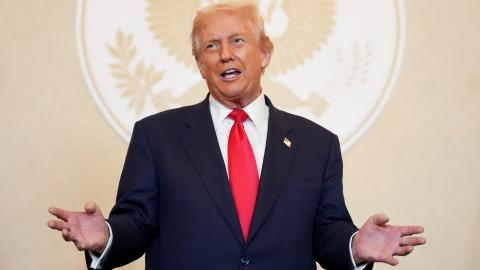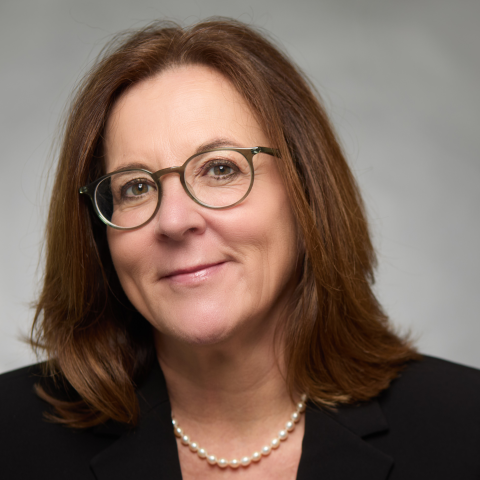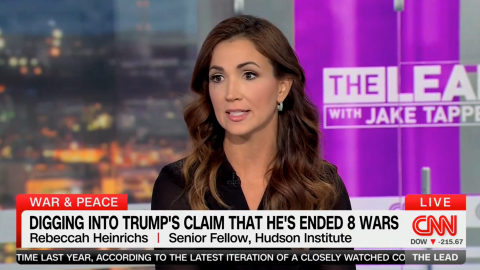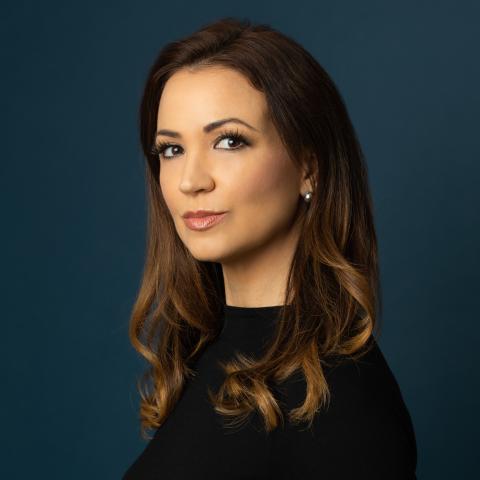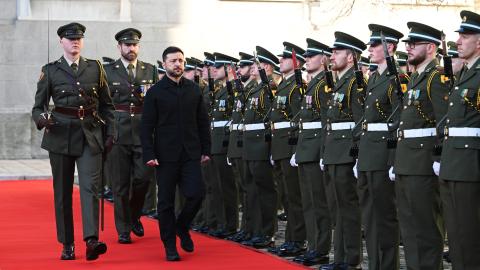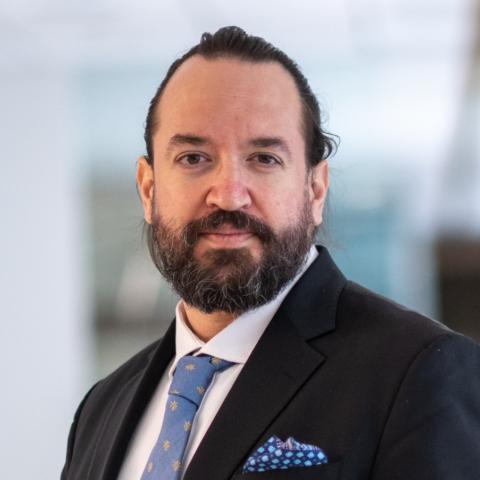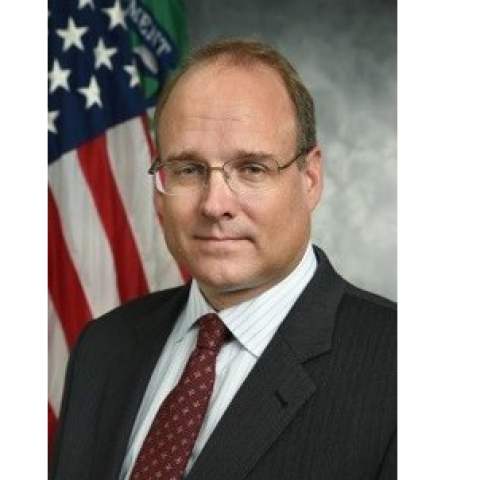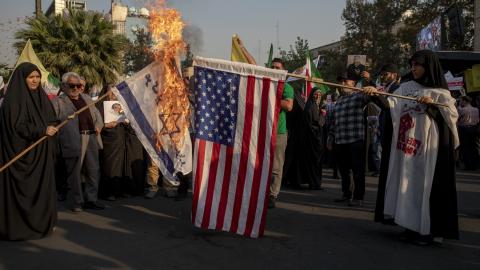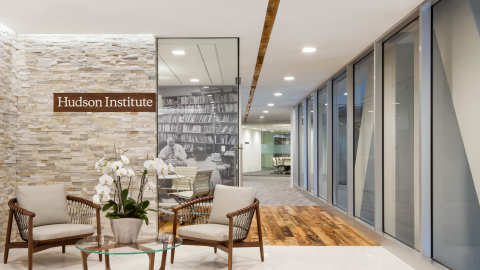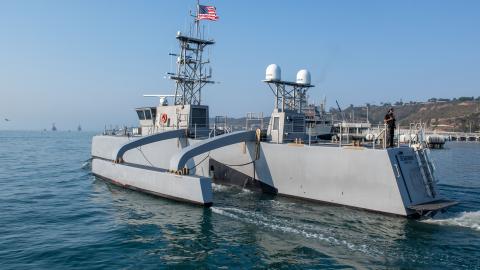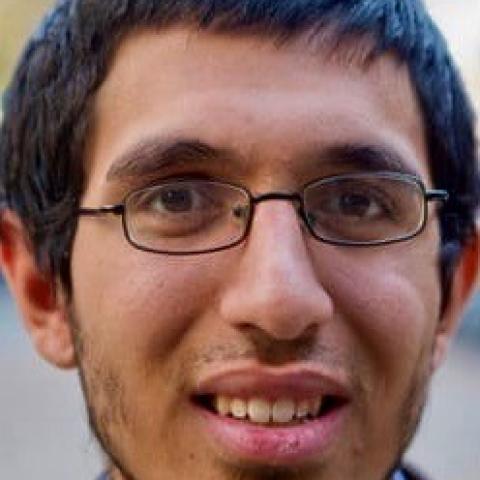In coverage of the Syrian civil war, which began with unrest in 2011 and culminated in the downfall of the Bashar al-Assad regime in December 2024, external observers have noted two important concerns: (1) the role of Iran and its wider “axis of resistance” in Syria and (2) the status of Syria’s minority communities. The story of two Twelver Shia villages in the northwest Syrian province of Idlib, al-Fua and Kafariya, provides an interesting case study in which these two issues became intricately intertwined.
The war displaced a Twelver Shia minority community1 in the nearby town of Maarat Misrin, many of whom migrated to al-Fua and Kafariya. These three communities constituted an isolated pocket of Twelver Shiism in the region and became the last bastion of regime loyalism in Idlib once insurgents overran the province in 2015. The insurgent offensive severed the link between the two villages and the provincial capital of Idlib city and thereby placed them under siege. Eventually, Iran mediated an agreement to evacuate the inhabitants of the two villages—a process that the Assad regime completed by July 2018.
Iran and the axis of resistance partly framed their intervention in Syria as aiming to protect Shiism and Shia communities in the country. However, in significant part because of the weakness of their local ally (the Assad regime), Iran and the axis essentially condemned the people of al-Fua and Kafariya to indefinite exile while their villages underwent a complete demographic change at the hands of insurgents. Meanwhile, with the fall of the Assad regime, the exiled villagers have largely found that Iran and the axis have abandoned them and left them unable to return to their homes, despite the new government’s rhetorical commitments to upholding coexistence and “civil peace.” This should raise concerns for all those who wish to see a genuinely pluralistic Syria emerge from the ruins of 14 years of war.
A key basis for this study is a memoir that details the two villages’ experiences during the civil war. Muhammad Hasan Taqi, a notable of al-Fua who headed the “crisis management committee” for the two villages once they came under siege, published the memoir in Syria in 2020. I translated it into English and published the translation with annotations at al-Mustafa University in Qom.2 However, I have also sought to cross-check and supplement the account through interviews with people from the two villages and other sources as well as using open-source data from social media and contemporary media reports.
This study, following the memoir, begins by briefly considering the status of the Twelver Shia communities of Idlib prior to the war. It then traces in greater detail the events from 2011 until 2018. It concludes by considering what might become of the two villages and their original inhabitants in the aftermath of the Assad regime’s fall in December 2024.
Al-Fua and Kafariya Before the War
It is not the place of this study to provide a detailed history of al-Fua and Kafariya prior to 2011, but al-Fua has existed since at least the medieval period. The Twelver Shia presence also extends into this period and is thus indigenous to the region for all intents and purposes. It is also likely that Shiism was more geographically widespread in the local area in this period than it was at the start of the civil war. According to the late Idlib historian Faiz Qawsara, after a Byzantine attack on greater Aleppo in 963 CE, the Shia Hamdanid ruler Sayf al-Dawla (r. 945–67) decided to bring some Shia inhabitants of the Harran area to defend the front lines against the Byzantines. Thus the “Shia madhhab [sect] spread in Aleppo, Sarmin,3 al-Fua, Maarat Misrin and other neighbouring villages.”4 The remarks of Ibn al-Wardi (d. 1348–49 CE) also suggest that in medieval times Shiism was more widespread in the area beyond al-Fua, Kafariya and Maarat Misrin. He records an instance of the conversion of some people in nearby Sarmin to Sunni Islam.5
In modern Syria just prior to the war in 2011, the government administratively classified al-Fua and Maarat Misrin as towns with estimated populations of 24,000 and 35,000 people respectively. It classified Kafariya, which had an estimated population of 9,700 prior to the civil war, as a locality. Of these three places, al-Fua and Kafariya were virtually entirely Shia as far as is discernable, while Maarat Misrin was a Sunni town and had a Shia minority numbering around only 2,500.6 The other towns and localities immediately neighboring al-Fua and Kafariya were and still are exclusively Sunni, while much farther northwest and near the border with Turkey are some Druze villages. Their inhabitants outwardly converted to Sunni Islam under pressure first from the Islamic State in 2013 and then from Jabhat al-Nusra in 2015.7
Accounts of relations before 2011 between the Shia and Sunnis (and other religious communities) of Idlib Province are generally positive. In his memoir, Taqi recounts that every year, the people of the province held a celebration commemorating the Prophet Muhammad’s birth, to which they invited “all the scholars of the region,” and a number of Sunni religious figures attended.8 A resident of the Druze village of Qalb Lawze attests that his own village and al-Fua enjoyed a “relation of affection and respect,” noting that he had many friends from al-Fua (regrettably, the source noted, those contacts have now been cut off).9 He added that he would not know, for example, whether “such-and-such doctor or such-and-such nurse” was among the Shia and that “no one would speak of these matters.”
However, Zaki, another resident of al-Fua who served in the information department of the “military formation in al-Fua and Kafariya” (discussed in greater detail later in this study), provided a different perspective. He noted that a few years before 2011, the villagers “began seeing the spread of Wahhabi thought in some of the countryside areas via Syrian preachers who had been in some of the Gulf states and Lebanon.”10 There is some plausibility to the claims about the growth of Salafism. Most notably, Abu Muhammad al-Adnani (real name given as Taha Subhi Falaha),11 who became notorious as the official spokesman for the Islamic State (among other functions), was reportedly from the town of Binnish12 just south of al-Fua.13 For his part, Taqi did not deny that there was a growth in Salafism prior to the war, but he denied that this translated into tangible anti-Shia sentiment, such as harassment or attacks.
Outbreak of Protests, Early Unrest, and Attempts at Conciliation (2011–12)
In his academic study focusing on the first year of protests against the regime in Syria, Kevin Mazur cautioned against characterizing the initial unrest through an exclusively ethnic or sectarian lens. He highlighted that members of ethno-religious groups besides the Sunni Arab majority participated in protests.14 Conversely, there were also members of that Sunni majority who did not seek to challenge the regime. Similarly, it is important to note that many grievances related to economic opportunities and political rights matched those that other “Arab Spring” protests voiced across the region.
However, what is of interest in this context is how the Shia communities in Idlib perceived the unrest in 2011–12. While some Shia in al-Fua, Kafariya, and Maarat Misrin might have sympathized with specific grievances about living standards and economic opportunities, the Shia communities as a whole rejected the revolution or regime change that quickly became a central demand of the protests. Amid the regime’s violent responses to many demonstrations, the unrest developed a militarized aspect early on, which likely reinforced their decision to stick by the regime.15 Shia loyalism to Assad’s government contrasted with the broad popularity of anti-regime demonstrations and support for armed insurgency among the communities’ Sunni neighbors. This in turn likely contributed to the perceived sectarian angle of the unrest that became a firmly entrenched reality over the course of 2011–12. The phenomenon of Shia in Idlib joining the cause of the revolution and the insurgency was wholly exceptional.16
Both Taqi’s memoir and other interviewees’ accounts reflect concerns about the nature of the demonstrations. Taqi, for example, speaks about the demand for “reform” as something “through which falsehood is intended” while also speaking of the demands for “regime change” and the emergence of “hateful sectarian slogans” against Shia.17 Zaki, an earlier mentioned interviewee, explained that “from the beginning we sensed danger for a number of reasons, among them that the sole demand was a dangerous demand—namely, to bring down the regime, including institutions, which means bringing down an entire country and making it easy prey for enemies.”18 He added that “this demand also posed a danger for minorities, as the demand to bring down the regime was accompanied by sectarian slogans.”19
As the unrest continued and the armed insurgency emerged and grew over the latter half of 2011 and the first half of 2012, the refusal of al-Fua and Kafariya to join the protestors and insurgents became a sticking point in relations between the two villages and their neighbors. As other communities siding with the Assad regime did, they formed so-called popular committees, which the Syrian regime’s military equipped and backed to enforce security at the local level. Through these committees, the two communities prevented the passage of any insurgents through the villages. By early 2012, tit-for-tat kidnappings began to occur: Insurgents began kidnapping state employees, members of the armed forces, or people they otherwise perceived as regime supporters (perhaps simply for being from al-Fua or Kafariya). The popular committees in al-Fua would kidnap insurgents and/or members of their families,20 and the two sides would then negotiate prisoner swaps.
In this period, there were multiple attempts, with support from the Assad regime and military in Idlib, to devise and implement “conciliation” initiatives between al-Fua and the Sunni-inhabited Binnish. However, none of them succeeded. It is clear in retrospect that attempts to mitigate the tensions between the two villages were bound to fail. They could not address the fundamental political divide between regime loyalists on one side and the political opposition and insurgency on the other.
For example, Taqi records that there were at least two written conciliation agreements between al-Fua and Binnish, one on February 25, 2012,21 arranged by a regime-aligned civil committee in Idlib, and a second that members of the Baath Party’s Idlib branch subsequently arranged (date unknown). In the first agreement, for which Taqi was al-Fua’s leading representative, notable clauses prohibited the use of weapons between the two sides, required the removal of all checkpoints between Binnish and al-Fua, and demanded a pledge by the people of al-Fua not to allow the Syrian army to enter Binnish via al-Fua. Some in al-Fua denounced the agreement as one of “humiliation” that bartered with the “blood of martyrs” and the two parties ultimately did not implement it. Taqi attributes this failure to “the individual positions of some men on our side and their side.”22
The second written agreement primarily focused on preventing tit-for-tat kidnappings and called for the release of all hostages by the two sides. Yet Taqi criticized what he considered the duplicity of the Binnish notables in maintaining links with the Syrian state and purporting to function as mediators. They were, in his view, still supporting the insurgents.23 Other interviewees from al-Fua and Kafariya said they supported the conciliation efforts and attributed their failure to the insurgents, who they claimed killed any member of the Syrian army, whether a volunteer or a conscript.
Amid the lack of any successful agreements, kidnappings continued. In July 2012, insurgents conducted a mass kidnapping of around 30 Shia men in the neighboring town of Maarat Misrin to secure ransoms and pressure the Shia to leave the town. This incident prompted the community’s exodus. Some headed to al-Fua and Kafariya, while others traveled farther to regime-held cities such as Tartus, Latakia, Aleppo, and Damascus.24
The Partial Siege of al-Fua and Kafariya (2012–15)
With the regime’s failure to manage the unrest amid the start of a full-blown insurgency and civil war, it lost control over large swaths of the Idlib countryside in the latter half of 2012 and early 2013. Thus, Taqi describes al-Fua and Kafariya as coming under “partial siege” during this period; virtually all the main localities surrounding al-Fua and Kafariya came under insurgent control. The regime's losses confined the connection between al-Fua, Kafariya, and other areas formally under regime control primarily to one route no more than 300 meters wide that linked the two villages with the provincial capital. There was also an older route paved with asphalt that passed just west of the main route and linked Idlib city with Maarat Misrin, which the fighters of al-Fua and Kafariya were obstructing to prevent insurgent advances. Thus, seizing the older route and/or the newer one became an objective for the insurgents in this period.25 Amid the deterioration in the military situation, the regime and its allies—Iran and Hezbollah—undertook efforts to bolster and organize popular committees throughout the country. The effort to bolster auxiliary forces was likely a product of the inherent weaknesses within the regime’s regular army, which was marred by desertions, harsh terms of conscription, corruption, and heavy casualties within the officer corps. From the perspectives of Iran and Hezbollah, it was strategically imperative to save the Assad regime as a key conduit for supplying Iranian and Syrian weapons to Hezbollah. The two actors were also driven by what they saw as a threat to Shiism and Shia in Syria and the wider region. Supporting local Syrian Shia communities also provided an opportunity to expand religious and cultural influence within those communities, bolstering ideological support for Iran and its axis of resistance.
And so, in late 2012 or early 2013, Lebanese Hezbollah personnel came to al-Fua and Kafariya and met with Mutiʿ Sulayman, a leader of popular committees in al-Fua, and Husayn al-Dabas, a leader of popular committees in Kafariya. Among these Hezbollah personnel were Jamil Faqih (al-Hajj Abu Yasir), al-Hajj Abu ʿAli, and al-Hajj Abu Mahdi. They made an agreement with the popular committee leaders to organize the committees into a single “Military Formation in al-Fua and Kafariya” under the overall command of these Hezbollah personnel and with financing from Hezbollah.26 Hezbollah also provided specialist training to bolster the fighters’ capabilities.27 In contrast to Hezbollah, there is no evidence that Iran ever deployed officers from its Islamic Revolutionary Guard Corps (IRGC) or personnel from other Iran-backed foreign militant groups to al-Fua and Kafariya.
On the wider level, the conflict in Syria was assuming an ever more sectarian tone; the most overt publicization of Hezbollah’s role in the conflict began with the Battle of al-Qusayr in Homs Governorate in 2013. Moreover, Iraqi Shia fighters—both those living in Syria prior to the war and those coming to Syria from Iraq—began advertising their involvement in the fighting. They framed it in religious terms, such as defending the shrine of Sayyida Zaynab in Damascus. In addition, 2013 was the year when the insurgency took on a much more overtly Sunni Islamist tone, and the role of Islamist, Salafist and jihadist groups became much more pronounced and obvious.
Local reports reflect the increasingly sectarian tone of the fighting between al-Fua and Kafariya on one side and the Sunni towns on the other side. For example, one pro-opposition page described a series of clashes in August 2013 between fighters in al-Fua and insurgents in Binnish as such: “Town of Binnish: renewal of intense clashes on the town’s northern front with the Shia Rafidites28 of the filthy people of al-Fua. Oh God, grant victory to our mujahidin brothers over the enemies of the religion.”29 In general, as the Idlibi journalist Zaina Erhaim (who supported the revolution) has observed, relations between al-Fua and Kafariya and their Sunni neighbors had devolved into one of “mutual kidnapping, killing on the basis of identity, and bombing from a distance.”30
The Fall of Idlib, Total Siege, and Evacuation (2015–18)
The assistance of Iran and its allies in the axis of resistance proved of value for the Assad regime in fending off the insurgency in parts of Damascus and areas near the border with Lebanon. But it could not prevent a wave of insurgent advances in Idlib in spring 2015 that began following the formation of the Jaysh al-Fath (Army of Conquest) coalition, which Jabhat al-Nusra and Ahrar al-Sham led. This coalition enjoyed the broad backing of the insurgency’s main foreign supporters at the time (Turkey, Qatar, and Saudi Arabia) who hoped insurgent advances would sufficiently pressure the regime to agree to a political transition.
In his memoir, Taqi gives the impression that the fall of Idlib city to the insurgents in March 2015 came as a surprise to him.31 However, at least some military personnel on the side of the regime and its allies must have anticipated it in light of the insurgents’ growing capabilities. Zaki says that he himself was “among the few who knew that Idlib would fall,” which led him to preemptively evacuate his family from al-Fua to Damascus.32
According to Zaki, during the 20 days prior to the offensive, he and his colleagues had received information about large-scale military mobilization by the insurgents, including convoys from the Aleppo area and the borders with Turkey. These convoys carried not only personnel but also artillery, tanks, and other equipment for use in an assault. Zaki added that the military formation in al-Fua and Kafariya conveyed information about this mobilization to the Syrian army, but the army made no meaningful response. This suggested to him that the Assad regime had chosen to strategically withdraw in the direction of al-Mastuma to the south of the city (only for al-Mastuma to subsequently fall as well because the army had underestimated the insurgents’ capabilities).
Seizing Idlib city and the route connecting it to al-Fua and Kafariya empowered the insurgents to impose a “total siege” on the two villages. The forces left to defend them were primarily the Hezbollah-affiliated military formation (including the Lebanese Hezbollah personnel commanding it) and the smaller National Defence Forces contingent.33 Only a few Syrian army personnel—around 10, including two officers—were left in the villages.34 According to Zaki, “It was possible for some of the army’s forces [when Idlib city fell] to withdraw towards the locality [of al-Fua], but orders were issued stipulating that any force withdrawing towards the locality would be considered as virtually defecting from the army, and thus we were left alone to our fate. We were literally abandoned.”35
With a loyalist Shia community under siege, the insurgents had some form of leverage against the regime and its Iranian and Hezbollah backers. To gain a form of counter-leverage (and out of other concerns, such as further securing the Syria-Lebanon border), the regime and Hezbollah launched an offensive in July 2015 against the insurgent-held town of al-Zabadani36 and tightened the siege on it.37 They also besieged the nearby town of Madaya.38 In turn, the insurgents in Idlib launched a number of attacks against al-Fua and Kafariya during July–September 2015.39 They probably did not intend to seize the villages outright (even if they portrayed their efforts as such at the time)40 but to force the Iranians and Hezbollah to negotiate over the status of al-Fua and Kafariya.
These battles indeed resulted in negotiations, marking the beginnings of what came to be widely known as the “four towns” agreement. The negotiations likely involved representatives of Hezbollah, Iran, the Assad regime, Qatar, and Turkey as well as Ahrar al-Sham and Jabhat al-Nusra. The four towns are al-Fua, Kafariya, and the Sunni-inhabited al-Zabadani and Madaya. This agreement initially stipulated a ceasefire for six months and mutual evacuations. The insurgents and all civilians who wished to leave al-Zabadani could go towards Idlib in return for the evacuation of 10,000 people from al-Fua and Kafariya, encompassing children under age 18, women, the elderly (those above age 50), and wounded people.41
Following this ceasefire agreement, the insurgents did not launch any further offensives against al-Fua and Kafariya, although skirmishes and mortar and sniper fire periodically continued until the final evacuation in July 2018.42 The parties finalized the four towns agreement at the end of March 2017, clearly with the end goal of the eventual complete evacuation of al-Fua and Kafariya.43
As Taqi attests in his memoir, no representatives from al-Fua and Kafariya played any direct role in the negotiations.44 This may partly reflect logistics: With the two villages’ representatives on the ground and isolated, it may have simply been too difficult to arrange evacuation flights for representatives to participate in negotiations held at least partly outside Syria. But Iran, Hezbollah, and the Assad regime may also have felt that having representatives from the two villages participate in the negotiations would impede their ability to reach an agreement, particularly given that the negotiations concerned whether the two villages’ inhabitants would remain in their homes. Whatever the case, the four towns agreement generated considerable resentment among the inhabitants of al-Fua and Kafariya, many of whom justifiably felt sidelined by the regime for whose preservation they had fought. They instead felt that international actors were hammering out their fates with no input from them.
Taking a Role in Humanitarian Efforts
Instead of participating in the negotiations, Taqi and other notables on the ground in al-Fua and Kafariya found their own role limited to addressing the humanitarian issues that the siege had generated. They tried to do so through a crisis management committee that they had set up as early as 2013.45 Taqi led the committee, which at its greatest extent comprised 13 members. Some of its members in turn headed subcommittees, such as a services committee, an education and culture committee, an agricultural committee, a health committee, and a technical committee.46 Some also served as representatives for Kafariya, which had its own committee. Two notable members of the crisis management committee were al-Hajj Sayyid Abu Hamza (a Hezbollah member who served as overall commander of the military formation) and al-Hajj Sadiq (a Hezbollah member who was responsible for the Kafariya front for the military formation).47 The committee likely included them because of their prominence in organizing the defense of the two villages.
Although a charitable association and the local Syrian Arab Red Crescent stored an initial stock of food supplies, these supplies could not last long, and prices quickly began to rise.48 There were, of course, ways to procure necessities. Smuggling was one such means. In his memoir, Taqi takes a largely unfavorable view of this practice, saying it brought in goods without considering whether they were needed, delivering little actual benefit to the people.49 The Lebanese Hezbollah personnel in al-Fua and Kafariya—in particular the earlier mentioned Jamil Faqih—tried to crack down on smuggling operations. Taqi even claims this crackdown led to Faqih’s “martyrdom.”50 His statement contradicts a hagiography of Faqih, which claims he was killed by bullets from a “takfiri sniper” (a Sunni insurgent).51 A second source from al-Fua clarified that those who killed Faqih were smugglers from Kafariya.52
Another source who served as commander of an Iran-backed formation called al-Ghalibun (which was not based in al-Fua and Kafariya but has extensive insights into the communities)53 told me the situation in al-Fua and Kafariya reflected “racism” among Lebanese personnel in dealing with the Syrian civilians, hoarding food supplies delivered via airdrop at the expense of the latter.54 Skirmishes between angry residents and the Hezbollah fighters consequently “took place and almost led to a catastrophe in the two besieged localities,” according to this source.55 The same source also corroborated the account that conflict between the Hezbollah personnel and smugglers from al-Fua and Kafariya led to Faqih's assassination.56
The villages also relied to some extent on aid deliveries by the Syrian Arab Red Crescent within the framework of the four towns agreement. However, the most important means of delivering necessities was the aforementioned airdrop method, which Taqi outlines in some detail in his memoir. He explains that the crisis management committee would contact the Damascus-based supply commission affiliated with Syrian Shia cleric al-Sayyid ʿAbdullah Nizham. The commission would then coordinate with the regime and the Iranians to arrange airdrops. Besides various food goods, the airdrops would also deliver medicines, fuel, metal equipment (e.g., machinery to operate a mill and even an oxygen generator),57 cash payments for Hezbollah-affiliated fighters,58 weapons and ammunition, and seeds for planting crops on agricultural land (although farming had become severely restricted by the insurgents’ attacks).59 Of course, delivery by airdrop entailed a significant risk of damage to the deliverables.
In general, the various methods of obtaining necessities at least helped prevent mass starvation, although there were many complaints that the supplies were insufficient for healthy nutrition and comfortable living. Zaki clarified that while he considered the crisis management committee’s performance “very good,” its capabilities were extremely limited. He explained that hunger was widespread, and he would see “people falling in the streets because of acute malnutrition.” His father eventually died because of a combination of malnutrition and lack of medicines.60 Life under siege also generated its own societal problems. For instance, theft became more commonplace.61 Taqi’s memoir also reveals tensions between his village of al-Fua and neighboring Kafariya regarding issues such as the proportions in which the committee divided supplies between the villages.62
Some details in Taqi’s memoir suggest local dissatisfaction with his work and opposition to him, to the point that there appears to have been more than one attempt to assassinate him.63 Like in many of the surrounding insurgent-held areas, there was no real democratic system in the form of regular popular elections to cement his legitimacy. Rather, his position was the result of consensus among local elites and Hezbollah personnel on the ground as well as consensus and coordination with the cleric al-Sayyid ʿAbdullah Nizham. Local social media posts from the time of the siege also corroborate the existence of dissatisfaction with the crisis management committee stemming from perceptions of the committee’s corruption and inability to meet humanitarian needs.64
Despite the humanitarian and social problems that the siege generated, Shia religious learning and cultural activities continued in al-Fua and Kafariya. Indeed, for Taqi and others, the suffering in the two villages recalled the Battle of Karbala and the suffering of Imam al-Husayn, and it was a matter of pride to display one’s Shia identity in the face of the challenges and dangers.65 The villagers ran a seminary (hawza) for women, though they ultimately suspended the classes in 2017 because of the consistent insurgent attacks and evacuation of large parts of the population.66 In addition, they continued to hold scouting activities for girls and boys.67
The Final Evacuation
The final evacuation of al-Fua and Kafariya took place in July 2018. Per Taqi’s memoir, it resulted from popular pressure. Members of the two communities by this time were aware of the military imbalance (in ammunition and manpower) between the local forces and the insurgents. Many also felt it was unlikely that the Syrian army and its allies would be able to break the siege in the near future. Residents wished to reunite with family members who had already evacuated as well, and they found the hardships that the prolonged siege imposed increasingly exhausting.68 Zaki expressed this sentiment: “In the beginning we did not want this [evacuation,] but in the end we faced two choices: either genocide and destruction of property, or leaving. This was because of the deficiency in fighting manpower and an acute deficiency in ammunition . . . any large attack [by the insurgents] would have been tantamount to the end, therefore the choice became leaving, as we were certain the army and friends would not be able to liberate [us].”69 Some residents, however, appeared surprised at the decision for a final, complete evacuation and wished to remain until the regime could break the siege.70
According to Taqi, the powers that had negotiated the four towns agreement agreed to complete the evacuation within 48 hours.71 On July 19, buses came and evacuated all the remaining people to Aleppo Province, from which the evacuees then dispersed further. The four towns agreement did not result in an exact swap of inhabitants between the two sets of locales. That is, it did not settle anyone from al-Fua and Kafariya in the Sunni towns of al-Zabadani or Madaya. Instead, it dispersed the original inhabitants of the Shia villages (and the Shia who had lived in Maarat Misrin) in a variety of locations throughout regions of Syria that the regime controlled, including Aleppo, the al-Sayyida Zaynab area in Damascus (which has a Shia community), and parts of Homs Governorate, Latakia, and Tartus.72
Al-Fua and Kafariya After the Evacuation
Understandably, the exile of al-Fua and Kafariya’s original inhabitants provoked considerable anguish about leaving behind property and memories of “martyred” relatives and ancestors.73 The departure also marked a definitive demographic transformation, as insurgent factions moved into the emptied locales and seized the properties for themselves. They divided al-Fua and Kafariya into “sectors” by factions, among them Jaysh al-Ahrar, Faylaq al-Sham, Hay’at Tahrir al-Sham (HTS, the successor to Jabhat al-Nusra that fully broke ties with al-Qaeda),74 and foreign fighter contingents (namely, Uzbeks and Uyghurs).75 However, the Salvation Government that was essentially the civilian wing of HTS came to administer the villages. This local administration initially took the form of one local council each for al-Fua and Kafariya, but services for the two locales subsequently became the responsibility of a larger municipal office for the “central region.”76
Displaced Syrian Sunnis from throughout Syria settled the two locales, paying rent to the factions that seized the dwellings. According to Abu ʿAli al-Zabadani, who left al-Zabadani (one of the insurgent-held towns that was part of the four towns agreement), most of those who left al-Zabadani for the north settled in al-Fua, while a minority settled in Maarat Misrin and Afrin (an originally Kurdish city whose inhabitants had been largely displaced by a Turkish-led operation in 2018).77 A displaced person from al-Zabadani even established a restaurant in al-Fua named Gates of al-Zabadani Restaurant.78
The Fall of the Assad Regime: A Lasting Demographic Shift?
Discussions of the Syrian civil war have frequently raised the issue of demographic change, often with the suspicion that various actors are deliberately engineering it. For instance, Syrians in the opposition as well as foreign commentators have claimed Iran was seeking to engineer demographic change by settling foreign Shia in areas from which Sunni Syrians had been displaced.79 Even now, one occasionally hears rumors in Syria of how the Assad regime supposedly naturalized hundreds of thousands or even millions of foreign Shia as Syrian citizens to alter the country’s demography, potentially influencing, for example, the outcomes of future elections.80
There is little concrete evidence to support these claims of such a strategic and concerted demographic shift by Iran or Assad. The claims also risk obscuring the very real large-scale displacements of Sunni Arab communities by the regime and its allies during military operations (to say nothing of the property rights violations that supporters of the regime committed).81 The story of al-Fua and Kafariya is a well-documented case of a localized demographic shift during the civil war, though one in which it was Sunnis who entirely replaced Shia.
Prior to the fall of the Assad regime in December 2024, al-Fua and Kafariya’s original inhabitants looked set to endure an indefinite exile amid what seemed to be a frozen conflict. The Assad regime was unable to retake the two locales because extensive Turkish military deployments in the area had effectively blocked further advances into Idlib Province since 2020. Russia accepted the deployments as part of a ceasefire deal for northwestern Syria. There also seemed to be little prospect of a political transition that international actors frequently touted as the only hope of resolving the conflict: The Assad regime proved unwilling to make any political concessions. Its intransigent stance was a deliberate strategy to get the wider international community to eventually accept the regime’s endurance and normalize relations. Although it was easy to dismiss rhetoric from HTS and other insurgents about continuing the revolution at the time, it is clear in retrospect that HTS effectively used the ceasefire arrangement in the northwest to rebuild its capabilities and find an opportune moment to go on the offensive again.
The fall of the Assad regime has now raised questions about the status and fate of Syria’s minorities, including its native Shia communities. Eager to present itself as worthy of international acceptance, the new government has made rhetorical commitments to protecting Syria’s minorities, including outreach to and meetings with leaders of those communities. This included a meeting in March 2025, for example, between Syrian president Ahmad al-Sharaa (known as Abu Muhammad al-Jowlani when he was leader of HTS) and a delegation of Syrian Shia. During the meeting, the delegation raised the need for the return of the Shia communities of al-Fua and Kafariya, Busra al-Sham (in Deraa province), and certain villages in Homs Governorate.82
As of this writing, the new government has taken no meaningful action to bring back the two villages’ original communities. One clear impediment is a problem that observers have noted elsewhere in Syria, namely whether displaced people actually have livable dwellings to return to. For example, according to one source from al-Zabadani, only a small proportion of the Sunnis now residing in al-Fua have actually returned home because a large proportion of their original homes in al-Zabadani remain destroyed.83 This same source states that while there has been talk about returning the original Shia inhabitants to al-Fua and Kafariya, the new government has not issued any formal decision or notified the people currently residing in the two villages that they must leave. However, another displaced person from al-Zabadani residing in al-Fua more recently claimed that most of the displaced from al-Zabadani residing in al-Fua have begun returning to their original homes.84 There is presently no evidence that the new government has prepared alternative accommodation for the people residing in the two villages.
Second, there are concerns about safety and security, especially among those Shia who supported the Assad regime. Taqi, for example, fled the country and says he cannot return barring a major change within Syria itself, noting that the security services found a copy of his memoir, thereby making him a wanted man.85 One resident of al-Fua who worked as a correspondent for the Iranian Arabic-language channel al-Alam (and has since left the country) could not bear to see “those who killed us, besieged us and displaced us do as they like and curse and boast about a lineage connected with the Umayyads.”86 This refers to a Sunni populist trend that has come to prominence since the fall of the Assad regime and is an outgrowth of the Sunni-centric vision of HTS. It ties Syria’s Sunni population to the legacy of the Umayyads, who ruled a vast empire based in Damascus.87 Some of this populism is linked to anti-Shia behavior, a notable example being footage that apparently showed the conversion of a Shia shrine in Aleppo (Mashhad al-Nuqta) into a Sunni school for teaching the Quran (or at least the removal of any banners and symbolism associated with Shiism).The video that circulated on social media featured the tag “Umayyads.”88
More generally, there have been multiple reports about assassinations and acts of violence against Shiain Homs Governorate and elsewhere,89 and a wave of online outrage from Sunnis forced the Sayyida Zaynab shrine in Damascus to remove its “Ya Zaynab” (“Oh Zaynab”) banners, supposedly because the hoisting of this banner was “sectarian.”90 In Jamil’s view, the people of al-Fua and Kafariya cannot return home when those who have written the constitution are “one group of one color, and are trying and striving to impose their control over everything.”91 For Abu Hasan (who is from al-Fua and remains in Syria), there is no prospect of return to his village, citing in particular alleged “threats” by people from Binnish and other surrounding localities against any of the original inhabitants who do.92
Even those from al-Fua and Kafariya who have been willing to support the ongoing political transition in principle do not expect to return to their homes imminently. One individual residing in Husya (a locality in Homs province where some displaced people from al-Fua and Kafariya are residing) noted that some Sunnis currently living in al-Fua and Kafariya are from Ghouta and their homes were destroyed by the Assad regime. As such, the source said, the new government cannot force them out while they lack homes in their own land. But in addition, the individual said the original inhabitants of al-Fua and Kafariya do not wish to return when “no one is giving us a security guarantee.”93
The new government likely finds that returning the people of al-Fua and Kafariya to their homes is too sensitive an issue to touch for now, given that displaced people are living in those villages and that an atmosphere of Sunni populism and associated anti-Shia sentiment prevails. Exile remains the reality for the villages’ original inhabitants for now—as it is for numerous Syrians of all sects—despite the widespread hopes that the fall of the Assad regime would create an opportunity for millions of displaced to return to their homes. In many cases, particularly for those who supported the anti-Assad uprising, return is simply not feasible at present for material reasons, e.g., widespread destruction and the slow pace of reconstruction. But some communities associated with past support for the regime, like those of al-Fua and Kafariya, will likely find themselves displaced for the foreseeable future for reasons of politics and identity as well.
